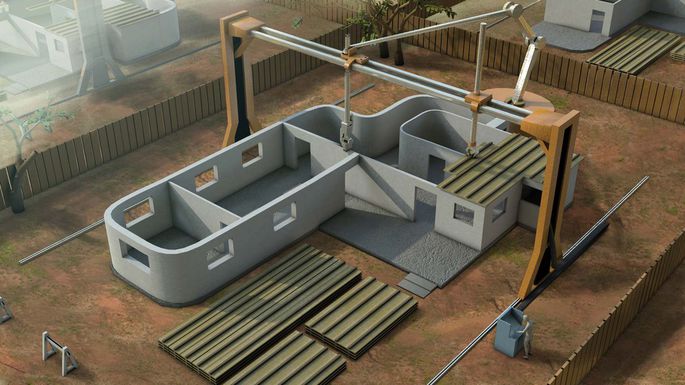Advance, innovate, be the best, the fastest, the lightest, the most ecological, the cheapest: the world is in perpetual evolution and this is felt as much at the level of the citizen as at the level of large companies or governments. Every organization must adapt to tomorrow's innovations. So, how has the arrival of 3D printing been perceived in large companies? Here's a closer look at the views of some of the major players.
A real potential for all sectors
Joe Desimone is the CEO of Carbon3D, a company that blends materials processing, software understanding and molecular science learning. Karl Lagerfeld is a renowned fashion designer. Yet, they don't differ much when it comes to 3D printing.
For Karl Lagerfeld, " the idea was to take the most iconic jacket of the 20th century and make a 21st century version of it, which would have been technically unthinkable at the time it was born.
Far from the spheres of high fashion, Joe Desimone presented at a TED conference a new printing method, inspired by the movie Terminator 2. He stated that it was " impossible to make these spheres with conventional methods. [...] This is a job for 3D printers ".
Other personalities have understood the interest of 3D printing
Raphaël Gorgé, CEO of the GORGÉ group, adds to these thoughts by saying that " 3D allows us to make complex parts that we never dared to imagine. "Now, " if you think of an object, you can make it ".
Pierre Prigent, CEO of Thales Morocco, clarifies the discourse: " Understand that this technology allows us to invent parts that we could not manufacture with traditional technologies. "
3D printing opens up new doors, unexplored avenues, for a change in working methods. "There is real potential," says Luc Stephan, Director of Innovation at Nantes Métropole Habitat.
Greg Haye, General Manager of Local Motors, confirms, " 3D printing allows for more complex geometries and is more efficient at producing lightweight structures.
3D printing: converging points of view
Today, parts that were thought to be impossible to make are created on their own, in ten minutes. The working methods used in the past may seem obsolete.
 " Twenty years ago, we started using it to make prototypes in a very short time. For the past five years, it has been used in production to make final parts or industrial molds. We are now starting a new phase: products will be designed from the outset to be 3D printed, in one go "explains Raphaël Gorgé, CEO of the GORGÉ group.
" Twenty years ago, we started using it to make prototypes in a very short time. For the past five years, it has been used in production to make final parts or industrial molds. We are now starting a new phase: products will be designed from the outset to be 3D printed, in one go "explains Raphaël Gorgé, CEO of the GORGÉ group.
The latter holds the same view as the leaders of Local Motors Giant factories, production lines, mass production of standardized objects at low cost, etc. Fordism is being called into question, especially since this model of organization and development no longer corresponds to consumers' expectations. Indeed, they are looking for personalized objects, good for health and respectful of the environment.
Pierre Prigent insists on the benefits of this 4.0 revolution: " Investments in the industry of the future (factory 4.0) allow us to be more integrated, more connected, more responsive and ultimately more competitive for the entire value chain for the benefit of everyone, customers and suppliers."
For Bertrand Demotes-Mainard, Vice President of Hardware Technologies for Thales, " 3D printing gives us great freedom in terms of shapes. It's also important to consider that " manufacturing a complex assembly in a single part [using this technique] results in weight savings. This is important in the satellite field where weight corresponds to cost. "
Damien Declerq, Executive Vice President of Local Motors, sees 3D printing as a way to " be closer to the needs of its customers" while also being an "asset for the environment.
Thierry De La Tour d'Artaise, CEO of the SEB Group, said that " 50% to 75% of the group's small appliance components would now be available as 3D files and printable on demand. " He is convinced that 3D printing is "a source of logistical simplification."
In the aeronautical industry, 3D printing also has a lot to offer. Knowing that " an aeronautical program lasts forty years, and that the production line evolves during this time, it is not easy to maintain the stock of spare parts, especially for parts that do not rotate much. It can take years before certain parts are used. [3D printing can solve this problem. Metal powder or filaments are easier to store than parts ," says Thierry Thomas, head of Safran's Additive Manufacturing Competence Center.
Large companies are therefore clearly opening up to these new technologies. In 2013, Barack Obama stated that " mastering this technology was strategic and would allow the United States to reindustrialize." This same hope was expressed by Raphaël Gorgé, who simply declared that " thanks to 3D printers, France would reindustrialize. "
However, like any revolution, the rise of 3D printing brings its own set of questions: employment, security, intellectual property, etc. Raphaël Gorgé answers some of these questions as follows: " No doubt. But, between a factory that integrates 3D printing in France and a French factory that relocates abroad, I clearly prefer option 1!


